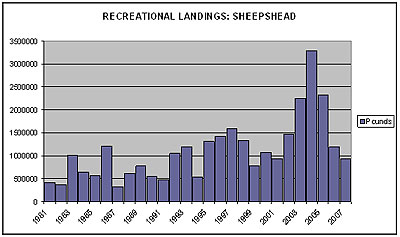| This black-barred saltwater fish undoubtedly got the name sheepshead because it has a downward-sloping snout and grazing/nipping teeth that look like a sheep’s. Along the way, it has also acquired numerous additional common names, including rondeau mouton (French), tete de mouton (Louisiana French), sargo chopa, pargo, rondeau mouton sargo (Spanish), kubinsky morskoi, karaś (Russian), sargo-choupa (Portuguese), sparus owczarz (Polish), sheepshead bream, bay snapper, sheepshead porgy, convict fish, striped bandit, rondeau seabream, jailhouse snapper, silver snapper and goat.
Newly-hatched larval sheepshead are carnivorous, feeding on zooplankton. Small juveniles continue to feed on zooplankton and add some bottom-dwelling organisms such as polychaetes, chironomid larvae, mysids and small mollusks. Large juveniles and smaller adults eat mollusks, crabs, other crustaceans and small fish. As adults, sheepshead eat a large variety of organisms, from 114 to 125 different species, according to different researchers. Almost any organic material that can be grazed from the bottom or from vertical substrates will be consumed, including plants.
Diet changes with the season, as availability changes. Small fishes are commonly preyed on in spring; plants and detritus are fed on most commonly in the summer, and polychaete worms occur more frequently in the diet during the spring, fall and winter. Mollusks and crustaceans are consumed year round. Because sheepshead feed heavily on live bottom, sessile invertebrates, they are probably important in controlling fouling communities and altering the diversity of live bottom fauna.
In the fall, sexually mature adults from inshore areas move offshore and congregate around reefs and other hard substrates in depths up to 120 feet. Nearly all adults remain offshore until spawning is over in late spring when most of the adult population returns to inshore habitats.
Sheepshead are delicious table fare, but are a bit tough to clean. Some anglers keep them but many throw them back. Two Louisiana creel studies documented them as the sixth and tenth most commonly retained marine species. Annual landings peaked in 2004 at 3.3 million pounds, but averages closer to a million pounds per year for recreational landings. The Louisiana state angling record (21.25 lbs) is also the world record, but recent Web postings indicate that heavier sheepshead may have been taken here.
Commercial harvest of sheepshead climbed steadily between 1981 and 1993, when 3.8 million pounds were taken in the state. Traditionally, most sheepshead have been taken as incidental catch in various nets, but commercial hook-and-line and trotline fishermen have landed a significant proportion in recent years.
Nearly all commercially caught sheepshead is sold to restaurants or markets in-state. Dockside value has never exceeded $0.40/lb whole-fish. Louisiana restaurateurs find that a fillet of “bay snapper” or “rondeau seabream” makes an excellent platform for a featured sauce or topping, but availability is not consistent.

Back
to Top |